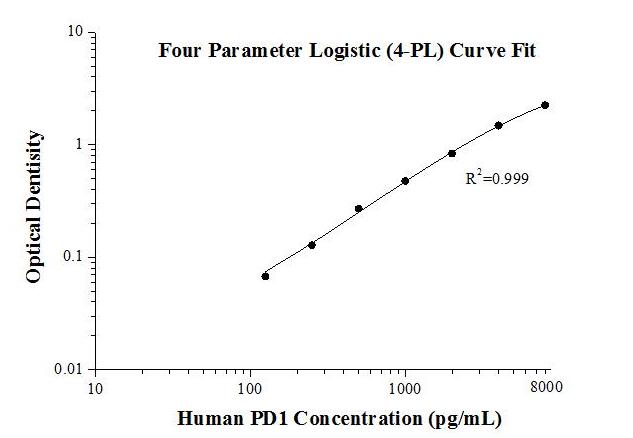Human PD1 ELISA Kit
Cat no : KE00075
Synonyms
CD279, hPD 1, hPD l, PD1, PD-1/CD279, PDCD1, programmed cell death 1, Protein PD 1, SLEB2
Validation Data Gallery
Product Information
KE00075 is a solid phase sandwich Enzyme Linked-Immuno-Sorbent Assay (Sandwich ELISA). The PD1 ELISA kit is to be used to detect and quantify protein levels of endogenous PD1. The assay recognizes human PD1. An antibody specific for PD1 has been pre-coated onto the microwells. The PD1 protein in samples is captured by the coated antibody after incubation. Following extensive washing, another antibody specific for PD1 is added to detect the captured PD1 protein. For signal development, horseradish peroxidase (HRP)-conjugated antibody is added, followed by Tetramethyl-benzidine (TMB) reagent. Solution containing sulfuric acid is used to stop color development and the color intensity which is proportional to the quantity of bound protein is measurable at 450 nm with the correction wavelength set at 630 nm.
| Product name | Human PD1 ELISA Kit |
| Tests | 1 X 96 well plate |
| Sample type | Serum, Plasma, Cell culture supernatants, Cell lysates |
| Assay type | Sandwich |
| Sensitivity | 43.0 pg/mL |
| Range | 125-8000 pg/mL |
| Reactivity | Human |
| Tested applications | Sandwich ELISA |
| Gene ID (NCBI) | 5133 |
Recovery
| Sample Type | Average | Range |
|---|---|---|
| Human plasma | 96% | 80%-116% |
| Cell lysates | 101% | 83%-120% |
| Cell culture supernatants | 95% | 79%-120% |
IntraAssay
| Sample | n | mean ( pg/mL) | SD | CV% |
|---|---|---|---|---|
| 1 | 20 | 7,390 | 191 | 2.6 |
| 2 | 20 | 2,176 | 81 | 3.7 |
| 3 | 20 | 542 | 14 | 2.6 |
InterAssay
| Sample | n | mean ( pg/mL) | SD | CV% |
|---|---|---|---|---|
| 1 | 24 | 7,796 | 382 | 4.9 |
| 2 | 24 | 2,399 | 139 | 5.8 |
| 3 | 24 | 539 | 27 | 5.0 |
Background Information
Programmed cell death 1 (PD-1, also known as CD279) is an immunoinhibitory receptor that belongs to the CD28/CTLA-4 subfamily of the Ig superfamily. It is a 288 amino acid (aa) type I transmembrane protein composed of one Ig superfamily domain, a stalk, a transmembrane domain, and an intracellular domain containing an immunoreceptor tyrosine-based inhibitory motif (ITIM) as well as an immunoreceptor tyrosine-based switch motif (ITSM). PD-1 can be expressed on activated T cells, B cells, natural killer T cells, monocytes, and dendritic cells (DCs). Engagement of PD-1 by its ligands PD-L1 or PD-L2 transduces a signal that inhibits T-cell proliferation, cytokine production, and cytolytic function. It is critical for the regulation of T cell function during tolerance, autoimmunity and infection. Blockade of PD-1 can overcome immune resistance and also has been shown to have antitumor activity.
Properties
| Storage Instructions | All the reagents are stored at 2-8℃ for 6 months or -20℃ for 12 months. Refer to the protocol for further storage instructions. |
| Synonyms | CD279, hPD 1, hPD l, PD1, PD-1/CD279, PDCD1, programmed cell death 1, Protein PD 1, SLEB2 |
Publications
| Species | Sample Type | Title |
|---|---|---|
Crit Care Lymphocyte subset expression and serum concentrations of PD-1/PD-L1 in sepsis - pilot study. | ||
Exp Ther Med Role of soluble programmed death-1 (sPD-1) and sPD-ligand 1 in patients with cystic echinococcosis. |
